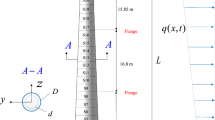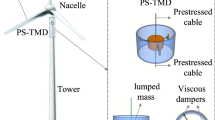Abstract
The Hefei TV tower is taken as an analytical case to examine the control method with a fluid viscous damper under wind load fluctuation. Firstly, according to the random vibration theory, the effect of fluctuating wind on the tower can be modeled as a 19-dimensional correlated random process, and the wind-induced vibration analysis of the tower subjected to dynamic wind load was further obtained. On the basis of the others’ works, a bimodel dynamic model is proposed. Finally, a dynamic model is proposed to study the wind-induced vibration control analysis using viscous fluid dampers, and the optimal damping coefficient is obtained regarding the wind-induced response of the upper turret as optimization objectives. Analysis results show that the maximum peak response of the tower under dynamic wind load is far beyond the allowable range of the code. The wind-induced responses and the wind vibration input energy of the tower are decreased greatly by using a fluid viscous damper, and the peak acceleration responses of the upper turret is reduced by 43.4%.
Similar content being viewed by others
References
Constantinou M C, Symans M D. Experimental and Analytical Investigation of Seismic Response of Structures with Supple Mental Fluid Viscous Dampers. NSEER Rep-92-0032. New York: State University of New York, 1992, 5–6
Ye Zhengqiang, Li Aiqun, Xu Youlin. Fluid Viscous damper technology and its engineering application for structural vibration energy dissipation. Journal of Southeast University (Natural Science Edition), 2002, 32(3): 466–473 (in Chinese)
Soong T T, Spencer B F. Supplemental energy dissipation: state-of-the art and state-of-the practice. Engineering Structures, 2002, 24(3): 243–259
Dicleli M, Mehta A. Seismic performance of chevron braced steel frames with and without viscous fluid dampers as a function of ground motion and damper characteristics. Journal of Constructional Steel Research, 2007, 63(8): 1102–1115
Zhou Yun, Deng Xuesong, Tang Tongbi, Wu Congxiao, Nie Yiheng, Ding Kun. State of the art and prospect of energy dissipation technology in China mainland. Earthquake Resistant Engineering and Retrofitting, 2006, 28(6): 1–15 (in Chinese)
Zhang Zhiqiang, Li Aiqun, Xu Youlin, Cai Danyi, He Jianping, Wang Jianlei. The 3D-dynamic finite element model established and dynamic characteristics analysis of Hefei TV Tower. Building Structure, 2003, 33(3): 50–53 (in Chinese)
Shinozuka M, Deodatis G. Simulation of stochastic processes by spectral representation. Applied Mechanics Review, 1991, 44(4): 191–203
Zhang Zhiqiang. Research on wind-induced and seismic vibration control of Hefei TV tower. Nanjing: School of Civil Engineering, Southeast University, 2003, 34–67 (in Chinese)
Xu Y L, Yang Z, Lu X L. Inelastic seismic response of adjacent buildings linked by fluid dampers. Structural Engineering and Mechanics, 2003, 15(5): 513–534
Xu Y L, Qu W L, Chen Z H. Control of wind-excited truss tower using semiactive friction damper. Journal of Structural Engineering, 2001, 127(8): 861–868
Xu Y L, Chen Z H, Qu W L. Dynamic analysis of wind-excited truss tower with friction dampers. Computers and Structures, 2001, 79(32): 2817–2831
Author information
Authors and Affiliations
Corresponding author
Additional information
__________
Translated from Journal of Southeast University (Natural Science Edition), 2008, 37(6): 1018–1022 [译自: 东南大学学报(自然科学版)]
Rights and permissions
About this article
Cite this article
Zhang, Z., Li, A., He, J. et al. Wind-induced vibration control of Hefei TV tower with fluid viscous damper. Front. Archit. Civ. Eng. China 3, 249–254 (2009). https://doi.org/10.1007/s11709-009-0038-x
Published:
Issue Date:
DOI: https://doi.org/10.1007/s11709-009-0038-x




